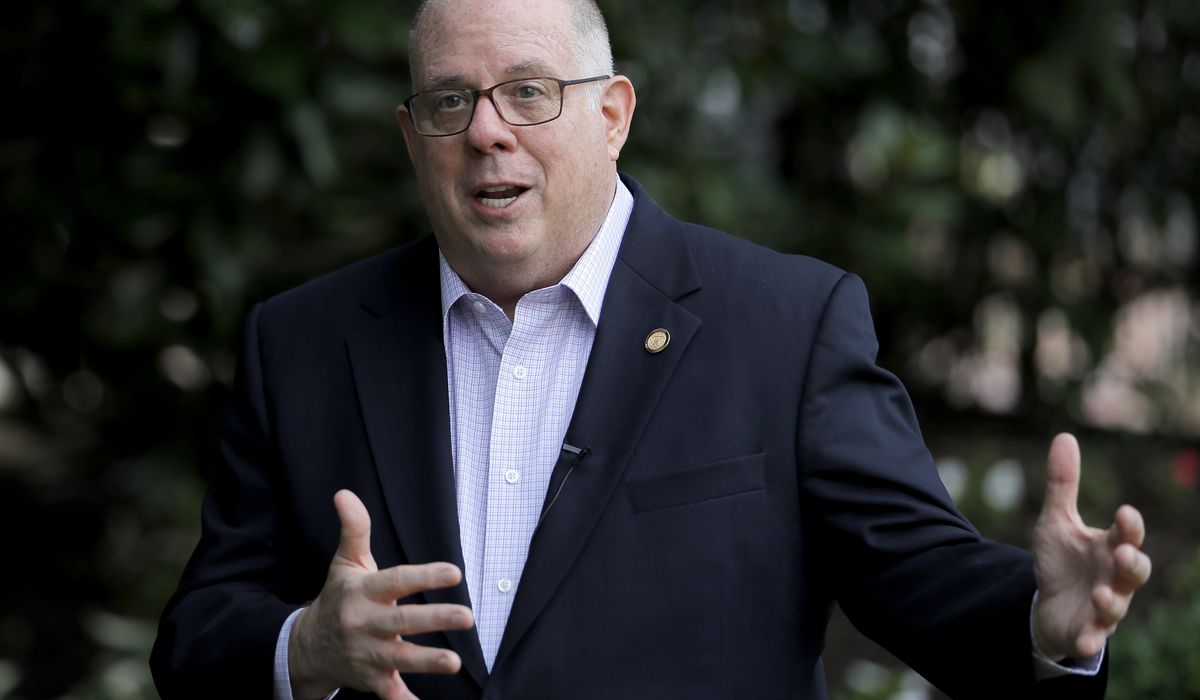Maryland Gov. Larry Hogan announced Wednesday a pause in his phased reopening plan, expanded the statewide mask mandate and issued a public health travel advisory for nine states, noting a recent increase in coronavirus hospitalizations.
Hospitalizations in Maryland have increased 28% in the past two weeks to 571, including 145 intensive care unit admissions, with largely younger patients taking up beds — enough to trigger a “stop sign” in moving from phase two to phase three of reopening, Mr. Hogan said.
“This virus can impact anyone, anywhere, of any age,” the Republican governor said at an afternoon press conference. “We are concerned and we’re closely monitoring hospitalizations,” he said.
As of Wednesday, Maryland recorded 86,285 positive cases and 3,347 deaths. The statewide positivity test rate is at 4.77% and has remained below the 5% goal for 34 consecutive days, Mr. Hogan. Only the city of Baltimore, Baltimore County and Prince George’s County have a positivity rate above 5%.
Mr. Hogan expanded on a previous order from April that will require individuals to wear masks in all indoor public buildings and outside public areas if physical distancing is not possible, beginning Friday at 5 p.m.
Maryland officials also issued a public health travel advisory, strongly urging people not to visit Florida, Texas, Georgia, Louisiana, Arizona, Alabama, South Carolina, Nebraska and Idaho, which have positivity test rates of 10% or higher.
“We are very concerned. We can’t stop people from crossing the borders. Things are pretty much out of control in some of these states,” Mr. Hogan said, asking anyone traveling to or from those states to get tested and self-quarantine for two weeks.
As of Monday, D.C. officials began requiring people coming into the city who traveled for nonessential reasons from 27 “high-risk” states to self-quarantine, leaving their homes or hotels only to receive medical care or to get food.
The states deemed high-risk by the D.C. Health Department are Arkansas, Arizona, Alabama, California, Delaware, Florida, Georgia, Idaho, Iowa, Kansas, Louisiana, Mississippi, Missouri, Montana, Nebraska, Nevada, New Mexico, North Carolina, North Dakota, Ohio, Oklahoma, South Carolina, Tennessee, Texas, Utah, Washington and Wisconsin.
Both Maryland and the District have been in the second phase of reopening since June.
Under phase two, many businesses such as gyms, restaurants, personal services and retailers opened with certain restrictions in place.
In the District, city officials announced Wednesday that they are lowering the positivity test rate threshold for moving to the next phase of reopening.
The previous benchmark of 10% has been lowered to 5% over a rolling seven-day average.
The District’s current seven-day average positivity test rate, which is the percentage of people who test positive over the total number of individuals tested, is 3.7% among residents, according to the latest health department data.
“We have been thoughtful in terms of the types of metrics we use and how to best measure our progress,” said Dr. LaQuandra Nesbitt, director of the D.C. Health Department, noting that earlier goals had set the positivity rate benchmark between 10% and 20% for a phased reopening.
“We now have far more evidence that suggests in order for rebound not to occur, for you to have a second peak or second wave after you turn on more activity, that percentage should be below five and, if in some instances you can keep it below three, even better,” Dr. Nesbitt said.
Officials also changed how they track the positivity rate and will instead record the rolling seven-day average rather than daily rates. This is to account for a dip in the total number of people tested over the weekends, which then leads to a higher test positivity rate on a single day.
Dr. Nesbitt noted that the best time to get tested is three to five days after a known exposure to someone ill with the coronavirus. Getting a test immediately after exposure is not typically advisable, she said, since the diagnostic test probably won’t pick up on an active virus replicating.
The Health Department reported 54 new positive coronavirus cases for Tuesday, bringing the total number of residents infected to 11,999.
A total of 584 D.C. residents have died from COVID-19. Data also shows a sustained transmission rate of 0.91, below the 1.0 rate needed to eventually stop the epidemic. Acute care hospitals are also currently at 74.1% capacity.
“Now is just not the time to travel to many locations where the virus is circulating and where you are more likely to be exposed, infected and then bring back that infection, that virus, to others,” Mayor Muriel Bowser said Wednesday at a press conference. “Examples of nonessential travel are beach trips, vacations and work conferences.”



















